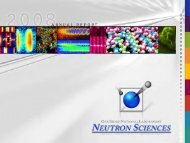MBraun UNIlab Glovebox System
MBraun UNIlab Glovebox System
MBraun UNIlab Glovebox System
Create successful ePaper yourself
Turn your PDF publications into a flip-book with our unique Google optimized e-Paper software.
ORNL<br />
<strong>MBraun</strong> <strong>UNIlab</strong><br />
<strong>Glovebox</strong> <strong>System</strong><br />
6<br />
Gloves<br />
Inner Antechamber<br />
Door<br />
5<br />
1<br />
Interactive<br />
Display<br />
4<br />
Pressure<br />
Gauge<br />
2<br />
Outer<br />
Antechamber<br />
Door<br />
3<br />
Antechambers
A<br />
B<br />
C<br />
D<br />
E<br />
F<br />
SETUP HAZARDS<br />
4<br />
Before proceeding, check the H20 and O2<br />
readings in the upperleft corner of the<br />
display and verify that the values are less<br />
than or equal to 0.1.<br />
If the values are not as<br />
indicated in A , please<br />
contact a LSM.<br />
To light the work area<br />
within the box, touch the<br />
“Boxlight” control on the<br />
panel.<br />
There are two antechambers on this<br />
model, a small forward chamber and<br />
a larger one toward the rear.<br />
To load materials into the box, first verify<br />
the pressure gauge on the chamber is<br />
reading 0, the inner door is closed, and<br />
the valve is in the closed position. 6<br />
Open the outer door by turning the knob<br />
in the center. Then slide the tray out and<br />
place materials on it. When the chaber is<br />
loaded, slide the tray back in and reseal<br />
the outer door.<br />
4<br />
1<br />
1<br />
2<br />
3<br />
G<br />
H<br />
I<br />
J<br />
K<br />
L<br />
Evacuate the small chamber by<br />
turning the valve to “evacuate”<br />
as indicated by the diagram<br />
below the pressure gauge.<br />
Once the pressure gauge has settled,<br />
allow 3 minutes for non-pourous and 12<br />
hours for pourous materials.<br />
Refill the chamber by turning the valve to<br />
“refill,” as indicated by the diagram. For<br />
non-porous materials, wait for the gauge<br />
to settle at the halfway point. For porous<br />
materials, wait for the gauge to settle at 0.<br />
For non-porous materials, repeat 2 more<br />
times with 3 minute evacuation cycles,<br />
refilling the chamber halfway then, finally<br />
to atmospheric pressure (0). For porous<br />
materials, repeat the procedure one more<br />
time, waiting another 12 hours for<br />
evacuation.<br />
Turn the valve to the “closed” position<br />
and open the inside antechamber door,<br />
slide the tray out, remove materials, then<br />
close the chamber.<br />
The procedure for the large<br />
antechamber is the same as for the<br />
small except the non-porous<br />
materials should have 5 minutes<br />
during evacuation instead of 3.<br />
4<br />
4<br />
6<br />
ELECTRICAL HAZARD<br />
This equipment is operated on a<br />
high voltage system and may<br />
remain charged after being<br />
powered off<br />
SUFFOCATION HAZARD<br />
There is a risk of asphyxiation when<br />
working with inert gasses.<br />
GENERAL HAZARDS<br />
Depending on the type of work being<br />
performed in the box, thermal,<br />
mechanical, electrical, and/or<br />
chemical hazards may be present.<br />
PREVENTION<br />
EYE PROTECTION<br />
Wear safety glasses while operating.<br />
PROTECTIVE GLOVES<br />
Wear appropriate gloves for heat and<br />
chemical usage.<br />
NON-SLIP, CLOSED SHOES<br />
Wear non-slip, closed shoes to avoid<br />
spills.<br />
READ MANUAL<br />
Become familiar with this guide<br />
before operating.<br />
For additional help contact the Lab<br />
Space Manager

















